Strategic Management: An Analysis of Tesla's Global Strategies
VerifiedAdded on 2022/07/20
|9
|3143
|58
Report
AI Summary
This report provides a comprehensive analysis of Tesla's strategic management within an international context. It begins with an introduction to Tesla's innovative approach and then delves into key aspects of its global strategy, including the demands for globalization and localization, and the reasons behind them. The report then explores Tesla's approach to open and closed innovation, examining the differences between the two and how they apply to Tesla's operations. Porter's Diamond Model is used to assess industry compliance and choice. The report also discusses the paradox of profitability and social responsibility, examining Tesla's purpose, corporate profitability, and corporate social responsibility (CSR). A personal reflection concludes the report, summarizing the key learning points and insights gained from the analysis of Tesla's strategic management practices. The report leverages the provided material to discuss Tesla's competitive advantage and its position in the market.
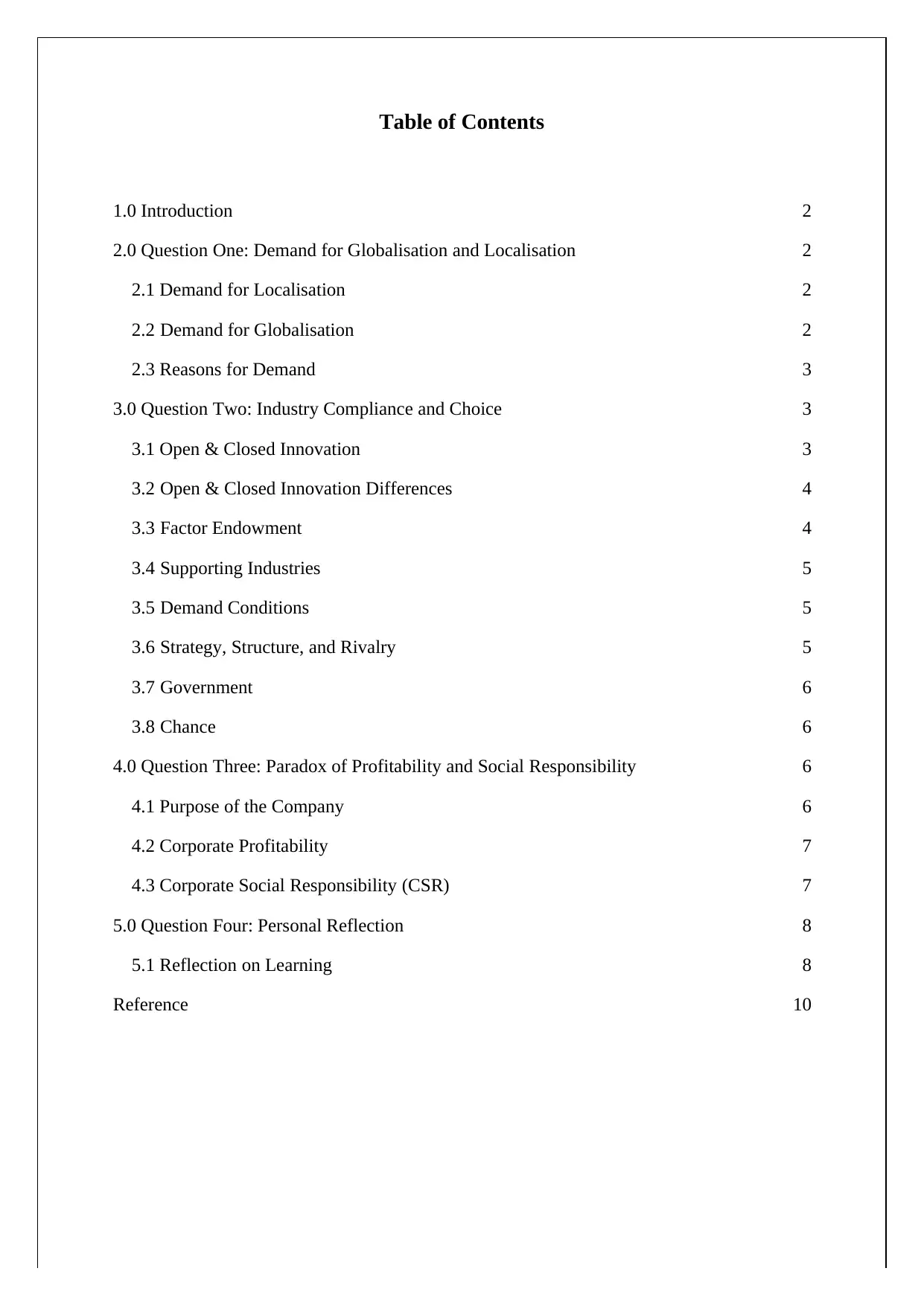
Table of Contents
1.0 Introduction 2
2.0 Question One: Demand for Globalisation and Localisation 2
2.1 Demand for Localisation 2
2.2 Demand for Globalisation 2
2.3 Reasons for Demand 3
3.0 Question Two: Industry Compliance and Choice 3
3.1 Open & Closed Innovation 3
3.2 Open & Closed Innovation Differences 4
3.3 Factor Endowment 4
3.4 Supporting Industries 5
3.5 Demand Conditions 5
3.6 Strategy, Structure, and Rivalry 5
3.7 Government 6
3.8 Chance 6
4.0 Question Three: Paradox of Profitability and Social Responsibility 6
4.1 Purpose of the Company 6
4.2 Corporate Profitability 7
4.3 Corporate Social Responsibility (CSR) 7
5.0 Question Four: Personal Reflection 8
5.1 Reflection on Learning 8
Reference 10
1.0 Introduction 2
2.0 Question One: Demand for Globalisation and Localisation 2
2.1 Demand for Localisation 2
2.2 Demand for Globalisation 2
2.3 Reasons for Demand 3
3.0 Question Two: Industry Compliance and Choice 3
3.1 Open & Closed Innovation 3
3.2 Open & Closed Innovation Differences 4
3.3 Factor Endowment 4
3.4 Supporting Industries 5
3.5 Demand Conditions 5
3.6 Strategy, Structure, and Rivalry 5
3.7 Government 6
3.8 Chance 6
4.0 Question Three: Paradox of Profitability and Social Responsibility 6
4.1 Purpose of the Company 6
4.2 Corporate Profitability 7
4.3 Corporate Social Responsibility (CSR) 7
5.0 Question Four: Personal Reflection 8
5.1 Reflection on Learning 8
Reference 10
Paraphrase This Document
Need a fresh take? Get an instant paraphrase of this document with our AI Paraphraser
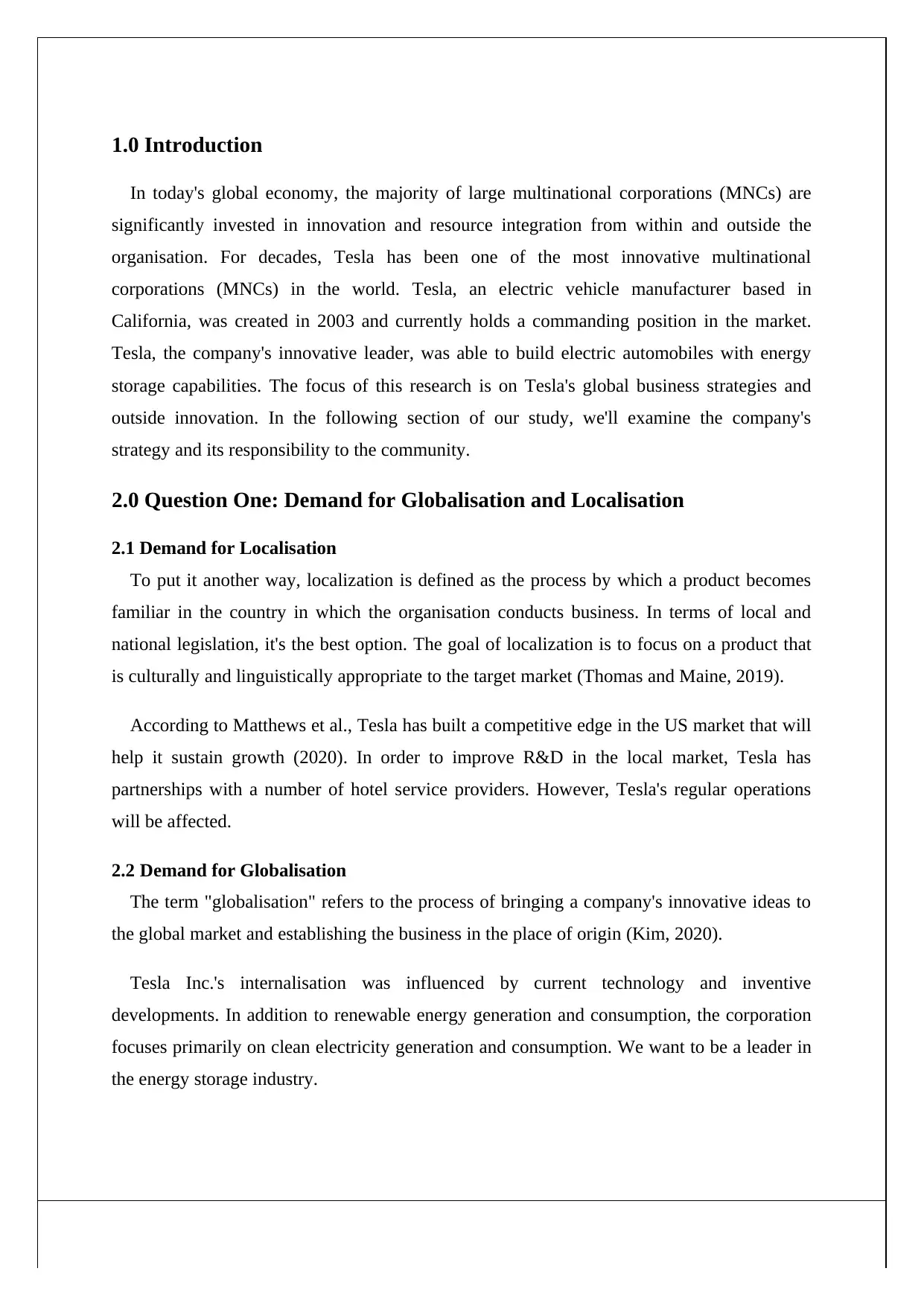
1.0 Introduction
In today's global economy, the majority of large multinational corporations (MNCs) are
significantly invested in innovation and resource integration from within and outside the
organisation. For decades, Tesla has been one of the most innovative multinational
corporations (MNCs) in the world. Tesla, an electric vehicle manufacturer based in
California, was created in 2003 and currently holds a commanding position in the market.
Tesla, the company's innovative leader, was able to build electric automobiles with energy
storage capabilities. The focus of this research is on Tesla's global business strategies and
outside innovation. In the following section of our study, we'll examine the company's
strategy and its responsibility to the community.
2.0 Question One: Demand for Globalisation and Localisation
2.1 Demand for Localisation
To put it another way, localization is defined as the process by which a product becomes
familiar in the country in which the organisation conducts business. In terms of local and
national legislation, it's the best option. The goal of localization is to focus on a product that
is culturally and linguistically appropriate to the target market (Thomas and Maine, 2019).
According to Matthews et al., Tesla has built a competitive edge in the US market that will
help it sustain growth (2020). In order to improve R&D in the local market, Tesla has
partnerships with a number of hotel service providers. However, Tesla's regular operations
will be affected.
2.2 Demand for Globalisation
The term "globalisation" refers to the process of bringing a company's innovative ideas to
the global market and establishing the business in the place of origin (Kim, 2020).
Tesla Inc.'s internalisation was influenced by current technology and inventive
developments. In addition to renewable energy generation and consumption, the corporation
focuses primarily on clean electricity generation and consumption. We want to be a leader in
the energy storage industry.
In today's global economy, the majority of large multinational corporations (MNCs) are
significantly invested in innovation and resource integration from within and outside the
organisation. For decades, Tesla has been one of the most innovative multinational
corporations (MNCs) in the world. Tesla, an electric vehicle manufacturer based in
California, was created in 2003 and currently holds a commanding position in the market.
Tesla, the company's innovative leader, was able to build electric automobiles with energy
storage capabilities. The focus of this research is on Tesla's global business strategies and
outside innovation. In the following section of our study, we'll examine the company's
strategy and its responsibility to the community.
2.0 Question One: Demand for Globalisation and Localisation
2.1 Demand for Localisation
To put it another way, localization is defined as the process by which a product becomes
familiar in the country in which the organisation conducts business. In terms of local and
national legislation, it's the best option. The goal of localization is to focus on a product that
is culturally and linguistically appropriate to the target market (Thomas and Maine, 2019).
According to Matthews et al., Tesla has built a competitive edge in the US market that will
help it sustain growth (2020). In order to improve R&D in the local market, Tesla has
partnerships with a number of hotel service providers. However, Tesla's regular operations
will be affected.
2.2 Demand for Globalisation
The term "globalisation" refers to the process of bringing a company's innovative ideas to
the global market and establishing the business in the place of origin (Kim, 2020).
Tesla Inc.'s internalisation was influenced by current technology and inventive
developments. In addition to renewable energy generation and consumption, the corporation
focuses primarily on clean electricity generation and consumption. We want to be a leader in
the energy storage industry.
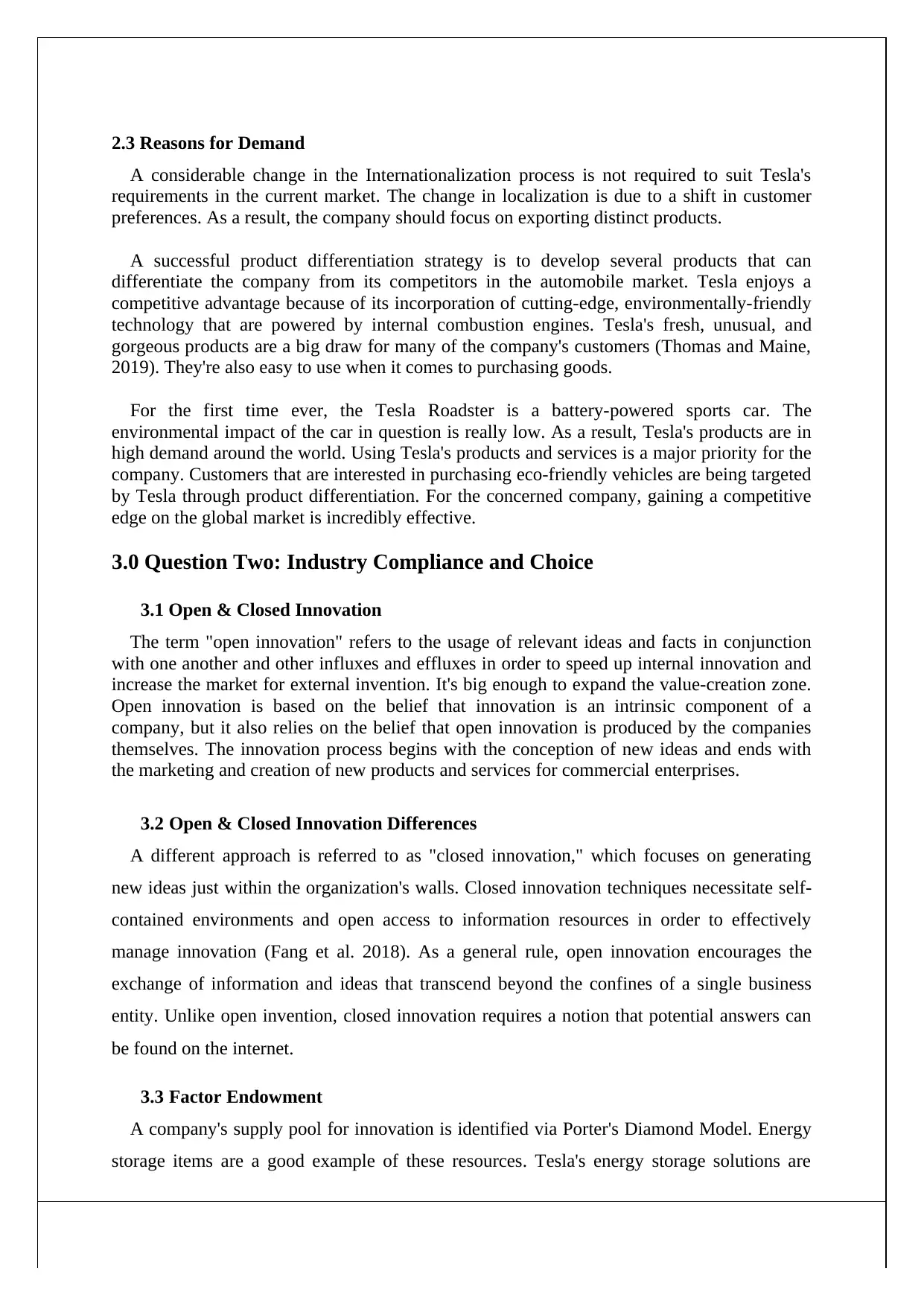
2.3 Reasons for Demand
A considerable change in the Internationalization process is not required to suit Tesla's
requirements in the current market. The change in localization is due to a shift in customer
preferences. As a result, the company should focus on exporting distinct products.
A successful product differentiation strategy is to develop several products that can
differentiate the company from its competitors in the automobile market. Tesla enjoys a
competitive advantage because of its incorporation of cutting-edge, environmentally-friendly
technology that are powered by internal combustion engines. Tesla's fresh, unusual, and
gorgeous products are a big draw for many of the company's customers (Thomas and Maine,
2019). They're also easy to use when it comes to purchasing goods.
For the first time ever, the Tesla Roadster is a battery-powered sports car. The
environmental impact of the car in question is really low. As a result, Tesla's products are in
high demand around the world. Using Tesla's products and services is a major priority for the
company. Customers that are interested in purchasing eco-friendly vehicles are being targeted
by Tesla through product differentiation. For the concerned company, gaining a competitive
edge on the global market is incredibly effective.
3.0 Question Two: Industry Compliance and Choice
3.1 Open & Closed Innovation
The term "open innovation" refers to the usage of relevant ideas and facts in conjunction
with one another and other influxes and effluxes in order to speed up internal innovation and
increase the market for external invention. It's big enough to expand the value-creation zone.
Open innovation is based on the belief that innovation is an intrinsic component of a
company, but it also relies on the belief that open innovation is produced by the companies
themselves. The innovation process begins with the conception of new ideas and ends with
the marketing and creation of new products and services for commercial enterprises.
3.2 Open & Closed Innovation Differences
A different approach is referred to as "closed innovation," which focuses on generating
new ideas just within the organization's walls. Closed innovation techniques necessitate self-
contained environments and open access to information resources in order to effectively
manage innovation (Fang et al. 2018). As a general rule, open innovation encourages the
exchange of information and ideas that transcend beyond the confines of a single business
entity. Unlike open invention, closed innovation requires a notion that potential answers can
be found on the internet.
3.3 Factor Endowment
A company's supply pool for innovation is identified via Porter's Diamond Model. Energy
storage items are a good example of these resources. Tesla's energy storage solutions are
A considerable change in the Internationalization process is not required to suit Tesla's
requirements in the current market. The change in localization is due to a shift in customer
preferences. As a result, the company should focus on exporting distinct products.
A successful product differentiation strategy is to develop several products that can
differentiate the company from its competitors in the automobile market. Tesla enjoys a
competitive advantage because of its incorporation of cutting-edge, environmentally-friendly
technology that are powered by internal combustion engines. Tesla's fresh, unusual, and
gorgeous products are a big draw for many of the company's customers (Thomas and Maine,
2019). They're also easy to use when it comes to purchasing goods.
For the first time ever, the Tesla Roadster is a battery-powered sports car. The
environmental impact of the car in question is really low. As a result, Tesla's products are in
high demand around the world. Using Tesla's products and services is a major priority for the
company. Customers that are interested in purchasing eco-friendly vehicles are being targeted
by Tesla through product differentiation. For the concerned company, gaining a competitive
edge on the global market is incredibly effective.
3.0 Question Two: Industry Compliance and Choice
3.1 Open & Closed Innovation
The term "open innovation" refers to the usage of relevant ideas and facts in conjunction
with one another and other influxes and effluxes in order to speed up internal innovation and
increase the market for external invention. It's big enough to expand the value-creation zone.
Open innovation is based on the belief that innovation is an intrinsic component of a
company, but it also relies on the belief that open innovation is produced by the companies
themselves. The innovation process begins with the conception of new ideas and ends with
the marketing and creation of new products and services for commercial enterprises.
3.2 Open & Closed Innovation Differences
A different approach is referred to as "closed innovation," which focuses on generating
new ideas just within the organization's walls. Closed innovation techniques necessitate self-
contained environments and open access to information resources in order to effectively
manage innovation (Fang et al. 2018). As a general rule, open innovation encourages the
exchange of information and ideas that transcend beyond the confines of a single business
entity. Unlike open invention, closed innovation requires a notion that potential answers can
be found on the internet.
3.3 Factor Endowment
A company's supply pool for innovation is identified via Porter's Diamond Model. Energy
storage items are a good example of these resources. Tesla's energy storage solutions are
⊘ This is a preview!⊘
Do you want full access?
Subscribe today to unlock all pages.

Trusted by 1+ million students worldwide
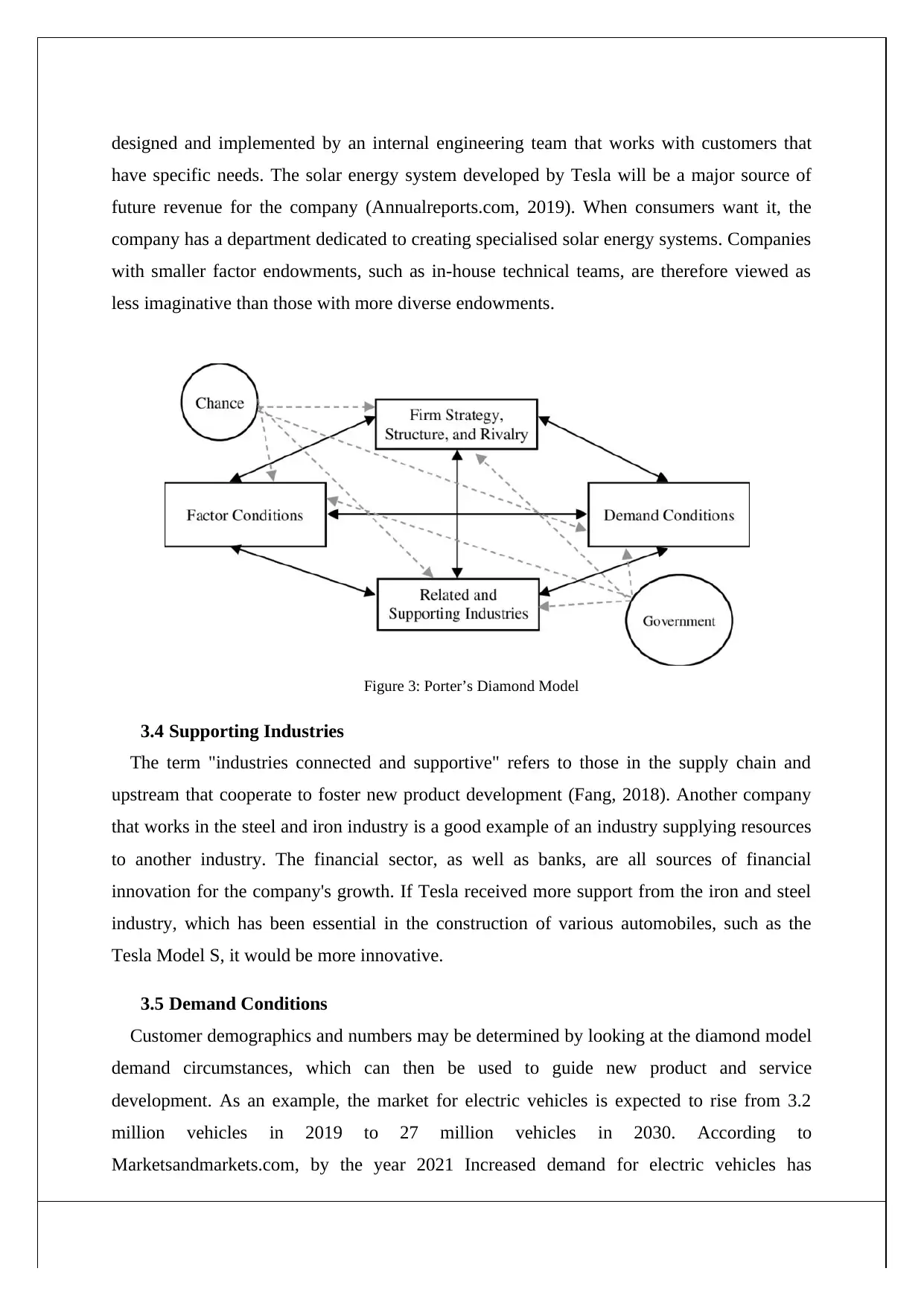
designed and implemented by an internal engineering team that works with customers that
have specific needs. The solar energy system developed by Tesla will be a major source of
future revenue for the company (Annualreports.com, 2019). When consumers want it, the
company has a department dedicated to creating specialised solar energy systems. Companies
with smaller factor endowments, such as in-house technical teams, are therefore viewed as
less imaginative than those with more diverse endowments.
Figure 3: Porter’s Diamond Model
3.4 Supporting Industries
The term "industries connected and supportive" refers to those in the supply chain and
upstream that cooperate to foster new product development (Fang, 2018). Another company
that works in the steel and iron industry is a good example of an industry supplying resources
to another industry. The financial sector, as well as banks, are all sources of financial
innovation for the company's growth. If Tesla received more support from the iron and steel
industry, which has been essential in the construction of various automobiles, such as the
Tesla Model S, it would be more innovative.
3.5 Demand Conditions
Customer demographics and numbers may be determined by looking at the diamond model
demand circumstances, which can then be used to guide new product and service
development. As an example, the market for electric vehicles is expected to rise from 3.2
million vehicles in 2019 to 27 million vehicles in 2030. According to
Marketsandmarkets.com, by the year 2021 Increased demand for electric vehicles has
have specific needs. The solar energy system developed by Tesla will be a major source of
future revenue for the company (Annualreports.com, 2019). When consumers want it, the
company has a department dedicated to creating specialised solar energy systems. Companies
with smaller factor endowments, such as in-house technical teams, are therefore viewed as
less imaginative than those with more diverse endowments.
Figure 3: Porter’s Diamond Model
3.4 Supporting Industries
The term "industries connected and supportive" refers to those in the supply chain and
upstream that cooperate to foster new product development (Fang, 2018). Another company
that works in the steel and iron industry is a good example of an industry supplying resources
to another industry. The financial sector, as well as banks, are all sources of financial
innovation for the company's growth. If Tesla received more support from the iron and steel
industry, which has been essential in the construction of various automobiles, such as the
Tesla Model S, it would be more innovative.
3.5 Demand Conditions
Customer demographics and numbers may be determined by looking at the diamond model
demand circumstances, which can then be used to guide new product and service
development. As an example, the market for electric vehicles is expected to rise from 3.2
million vehicles in 2019 to 27 million vehicles in 2030. According to
Marketsandmarkets.com, by the year 2021 Increased demand for electric vehicles has
Paraphrase This Document
Need a fresh take? Get an instant paraphrase of this document with our AI Paraphraser
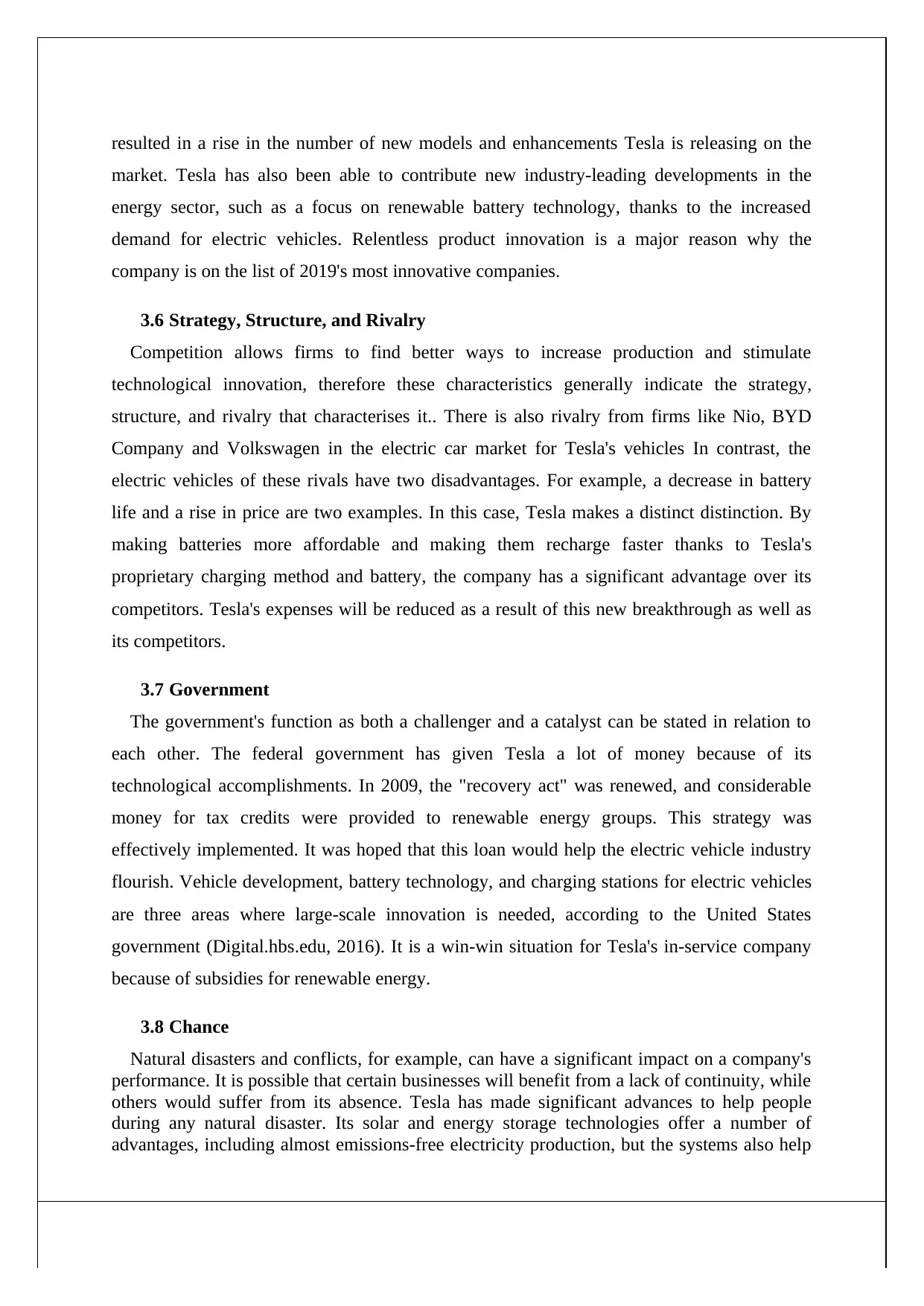
resulted in a rise in the number of new models and enhancements Tesla is releasing on the
market. Tesla has also been able to contribute new industry-leading developments in the
energy sector, such as a focus on renewable battery technology, thanks to the increased
demand for electric vehicles. Relentless product innovation is a major reason why the
company is on the list of 2019's most innovative companies.
3.6 Strategy, Structure, and Rivalry
Competition allows firms to find better ways to increase production and stimulate
technological innovation, therefore these characteristics generally indicate the strategy,
structure, and rivalry that characterises it.. There is also rivalry from firms like Nio, BYD
Company and Volkswagen in the electric car market for Tesla's vehicles In contrast, the
electric vehicles of these rivals have two disadvantages. For example, a decrease in battery
life and a rise in price are two examples. In this case, Tesla makes a distinct distinction. By
making batteries more affordable and making them recharge faster thanks to Tesla's
proprietary charging method and battery, the company has a significant advantage over its
competitors. Tesla's expenses will be reduced as a result of this new breakthrough as well as
its competitors.
3.7 Government
The government's function as both a challenger and a catalyst can be stated in relation to
each other. The federal government has given Tesla a lot of money because of its
technological accomplishments. In 2009, the "recovery act" was renewed, and considerable
money for tax credits were provided to renewable energy groups. This strategy was
effectively implemented. It was hoped that this loan would help the electric vehicle industry
flourish. Vehicle development, battery technology, and charging stations for electric vehicles
are three areas where large-scale innovation is needed, according to the United States
government (Digital.hbs.edu, 2016). It is a win-win situation for Tesla's in-service company
because of subsidies for renewable energy.
3.8 Chance
Natural disasters and conflicts, for example, can have a significant impact on a company's
performance. It is possible that certain businesses will benefit from a lack of continuity, while
others would suffer from its absence. Tesla has made significant advances to help people
during any natural disaster. Its solar and energy storage technologies offer a number of
advantages, including almost emissions-free electricity production, but the systems also help
market. Tesla has also been able to contribute new industry-leading developments in the
energy sector, such as a focus on renewable battery technology, thanks to the increased
demand for electric vehicles. Relentless product innovation is a major reason why the
company is on the list of 2019's most innovative companies.
3.6 Strategy, Structure, and Rivalry
Competition allows firms to find better ways to increase production and stimulate
technological innovation, therefore these characteristics generally indicate the strategy,
structure, and rivalry that characterises it.. There is also rivalry from firms like Nio, BYD
Company and Volkswagen in the electric car market for Tesla's vehicles In contrast, the
electric vehicles of these rivals have two disadvantages. For example, a decrease in battery
life and a rise in price are two examples. In this case, Tesla makes a distinct distinction. By
making batteries more affordable and making them recharge faster thanks to Tesla's
proprietary charging method and battery, the company has a significant advantage over its
competitors. Tesla's expenses will be reduced as a result of this new breakthrough as well as
its competitors.
3.7 Government
The government's function as both a challenger and a catalyst can be stated in relation to
each other. The federal government has given Tesla a lot of money because of its
technological accomplishments. In 2009, the "recovery act" was renewed, and considerable
money for tax credits were provided to renewable energy groups. This strategy was
effectively implemented. It was hoped that this loan would help the electric vehicle industry
flourish. Vehicle development, battery technology, and charging stations for electric vehicles
are three areas where large-scale innovation is needed, according to the United States
government (Digital.hbs.edu, 2016). It is a win-win situation for Tesla's in-service company
because of subsidies for renewable energy.
3.8 Chance
Natural disasters and conflicts, for example, can have a significant impact on a company's
performance. It is possible that certain businesses will benefit from a lack of continuity, while
others would suffer from its absence. Tesla has made significant advances to help people
during any natural disaster. Its solar and energy storage technologies offer a number of
advantages, including almost emissions-free electricity production, but the systems also help
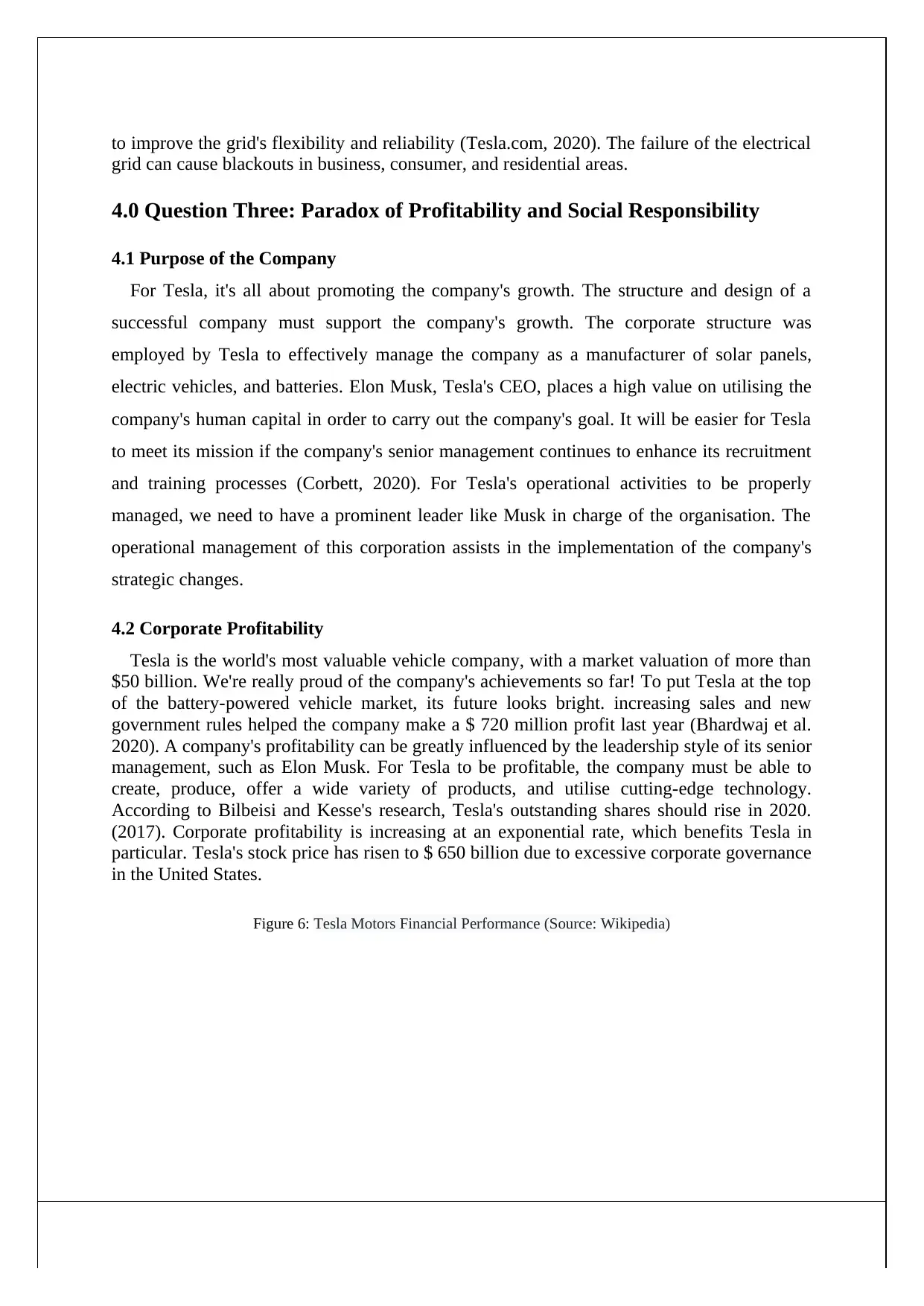
to improve the grid's flexibility and reliability (Tesla.com, 2020). The failure of the electrical
grid can cause blackouts in business, consumer, and residential areas.
4.0 Question Three: Paradox of Profitability and Social Responsibility
4.1 Purpose of the Company
For Tesla, it's all about promoting the company's growth. The structure and design of a
successful company must support the company's growth. The corporate structure was
employed by Tesla to effectively manage the company as a manufacturer of solar panels,
electric vehicles, and batteries. Elon Musk, Tesla's CEO, places a high value on utilising the
company's human capital in order to carry out the company's goal. It will be easier for Tesla
to meet its mission if the company's senior management continues to enhance its recruitment
and training processes (Corbett, 2020). For Tesla's operational activities to be properly
managed, we need to have a prominent leader like Musk in charge of the organisation. The
operational management of this corporation assists in the implementation of the company's
strategic changes.
4.2 Corporate Profitability
Tesla is the world's most valuable vehicle company, with a market valuation of more than
$50 billion. We're really proud of the company's achievements so far! To put Tesla at the top
of the battery-powered vehicle market, its future looks bright. increasing sales and new
government rules helped the company make a $ 720 million profit last year (Bhardwaj et al.
2020). A company's profitability can be greatly influenced by the leadership style of its senior
management, such as Elon Musk. For Tesla to be profitable, the company must be able to
create, produce, offer a wide variety of products, and utilise cutting-edge technology.
According to Bilbeisi and Kesse's research, Tesla's outstanding shares should rise in 2020.
(2017). Corporate profitability is increasing at an exponential rate, which benefits Tesla in
particular. Tesla's stock price has risen to $ 650 billion due to excessive corporate governance
in the United States.
Figure 6: Tesla Motors Financial Performance (Source: Wikipedia)
grid can cause blackouts in business, consumer, and residential areas.
4.0 Question Three: Paradox of Profitability and Social Responsibility
4.1 Purpose of the Company
For Tesla, it's all about promoting the company's growth. The structure and design of a
successful company must support the company's growth. The corporate structure was
employed by Tesla to effectively manage the company as a manufacturer of solar panels,
electric vehicles, and batteries. Elon Musk, Tesla's CEO, places a high value on utilising the
company's human capital in order to carry out the company's goal. It will be easier for Tesla
to meet its mission if the company's senior management continues to enhance its recruitment
and training processes (Corbett, 2020). For Tesla's operational activities to be properly
managed, we need to have a prominent leader like Musk in charge of the organisation. The
operational management of this corporation assists in the implementation of the company's
strategic changes.
4.2 Corporate Profitability
Tesla is the world's most valuable vehicle company, with a market valuation of more than
$50 billion. We're really proud of the company's achievements so far! To put Tesla at the top
of the battery-powered vehicle market, its future looks bright. increasing sales and new
government rules helped the company make a $ 720 million profit last year (Bhardwaj et al.
2020). A company's profitability can be greatly influenced by the leadership style of its senior
management, such as Elon Musk. For Tesla to be profitable, the company must be able to
create, produce, offer a wide variety of products, and utilise cutting-edge technology.
According to Bilbeisi and Kesse's research, Tesla's outstanding shares should rise in 2020.
(2017). Corporate profitability is increasing at an exponential rate, which benefits Tesla in
particular. Tesla's stock price has risen to $ 650 billion due to excessive corporate governance
in the United States.
Figure 6: Tesla Motors Financial Performance (Source: Wikipedia)
⊘ This is a preview!⊘
Do you want full access?
Subscribe today to unlock all pages.

Trusted by 1+ million students worldwide
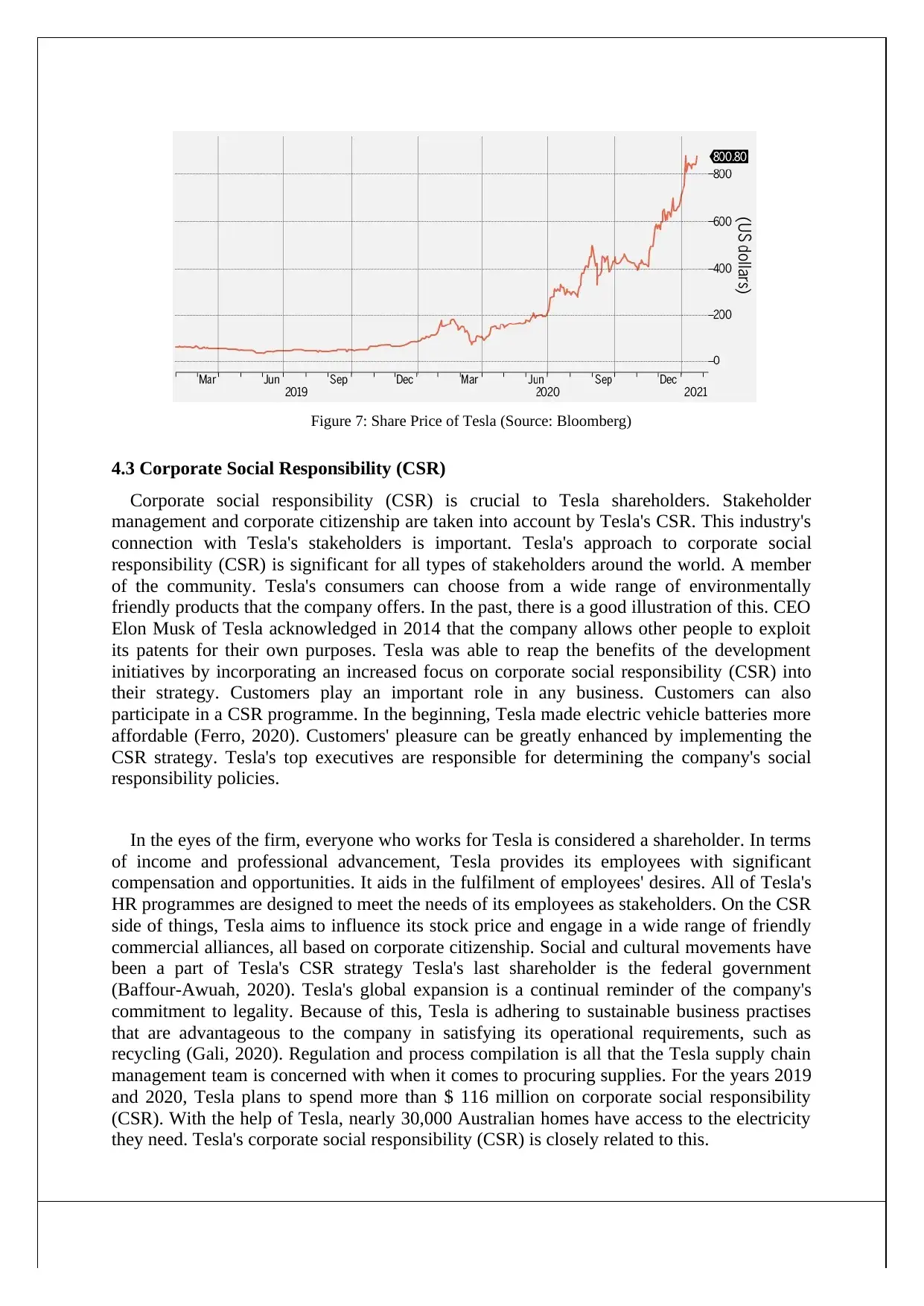
Figure 7: Share Price of Tesla (Source: Bloomberg)
4.3 Corporate Social Responsibility (CSR)
Corporate social responsibility (CSR) is crucial to Tesla shareholders. Stakeholder
management and corporate citizenship are taken into account by Tesla's CSR. This industry's
connection with Tesla's stakeholders is important. Tesla's approach to corporate social
responsibility (CSR) is significant for all types of stakeholders around the world. A member
of the community. Tesla's consumers can choose from a wide range of environmentally
friendly products that the company offers. In the past, there is a good illustration of this. CEO
Elon Musk of Tesla acknowledged in 2014 that the company allows other people to exploit
its patents for their own purposes. Tesla was able to reap the benefits of the development
initiatives by incorporating an increased focus on corporate social responsibility (CSR) into
their strategy. Customers play an important role in any business. Customers can also
participate in a CSR programme. In the beginning, Tesla made electric vehicle batteries more
affordable (Ferro, 2020). Customers' pleasure can be greatly enhanced by implementing the
CSR strategy. Tesla's top executives are responsible for determining the company's social
responsibility policies.
In the eyes of the firm, everyone who works for Tesla is considered a shareholder. In terms
of income and professional advancement, Tesla provides its employees with significant
compensation and opportunities. It aids in the fulfilment of employees' desires. All of Tesla's
HR programmes are designed to meet the needs of its employees as stakeholders. On the CSR
side of things, Tesla aims to influence its stock price and engage in a wide range of friendly
commercial alliances, all based on corporate citizenship. Social and cultural movements have
been a part of Tesla's CSR strategy Tesla's last shareholder is the federal government
(Baffour-Awuah, 2020). Tesla's global expansion is a continual reminder of the company's
commitment to legality. Because of this, Tesla is adhering to sustainable business practises
that are advantageous to the company in satisfying its operational requirements, such as
recycling (Gali, 2020). Regulation and process compilation is all that the Tesla supply chain
management team is concerned with when it comes to procuring supplies. For the years 2019
and 2020, Tesla plans to spend more than $ 116 million on corporate social responsibility
(CSR). With the help of Tesla, nearly 30,000 Australian homes have access to the electricity
they need. Tesla's corporate social responsibility (CSR) is closely related to this.
4.3 Corporate Social Responsibility (CSR)
Corporate social responsibility (CSR) is crucial to Tesla shareholders. Stakeholder
management and corporate citizenship are taken into account by Tesla's CSR. This industry's
connection with Tesla's stakeholders is important. Tesla's approach to corporate social
responsibility (CSR) is significant for all types of stakeholders around the world. A member
of the community. Tesla's consumers can choose from a wide range of environmentally
friendly products that the company offers. In the past, there is a good illustration of this. CEO
Elon Musk of Tesla acknowledged in 2014 that the company allows other people to exploit
its patents for their own purposes. Tesla was able to reap the benefits of the development
initiatives by incorporating an increased focus on corporate social responsibility (CSR) into
their strategy. Customers play an important role in any business. Customers can also
participate in a CSR programme. In the beginning, Tesla made electric vehicle batteries more
affordable (Ferro, 2020). Customers' pleasure can be greatly enhanced by implementing the
CSR strategy. Tesla's top executives are responsible for determining the company's social
responsibility policies.
In the eyes of the firm, everyone who works for Tesla is considered a shareholder. In terms
of income and professional advancement, Tesla provides its employees with significant
compensation and opportunities. It aids in the fulfilment of employees' desires. All of Tesla's
HR programmes are designed to meet the needs of its employees as stakeholders. On the CSR
side of things, Tesla aims to influence its stock price and engage in a wide range of friendly
commercial alliances, all based on corporate citizenship. Social and cultural movements have
been a part of Tesla's CSR strategy Tesla's last shareholder is the federal government
(Baffour-Awuah, 2020). Tesla's global expansion is a continual reminder of the company's
commitment to legality. Because of this, Tesla is adhering to sustainable business practises
that are advantageous to the company in satisfying its operational requirements, such as
recycling (Gali, 2020). Regulation and process compilation is all that the Tesla supply chain
management team is concerned with when it comes to procuring supplies. For the years 2019
and 2020, Tesla plans to spend more than $ 116 million on corporate social responsibility
(CSR). With the help of Tesla, nearly 30,000 Australian homes have access to the electricity
they need. Tesla's corporate social responsibility (CSR) is closely related to this.
Paraphrase This Document
Need a fresh take? Get an instant paraphrase of this document with our AI Paraphraser
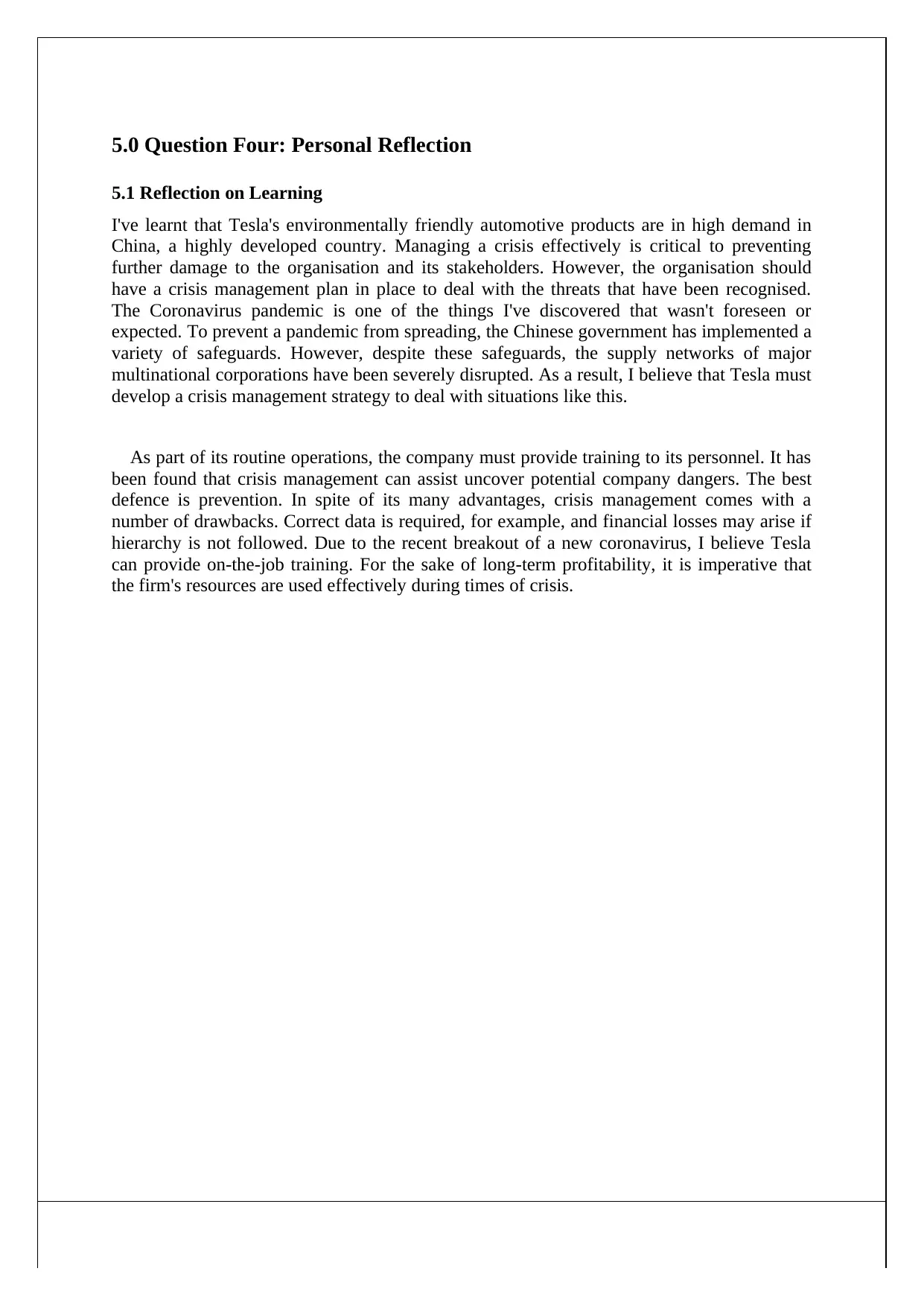
5.0 Question Four: Personal Reflection
5.1 Reflection on Learning
I've learnt that Tesla's environmentally friendly automotive products are in high demand in
China, a highly developed country. Managing a crisis effectively is critical to preventing
further damage to the organisation and its stakeholders. However, the organisation should
have a crisis management plan in place to deal with the threats that have been recognised.
The Coronavirus pandemic is one of the things I've discovered that wasn't foreseen or
expected. To prevent a pandemic from spreading, the Chinese government has implemented a
variety of safeguards. However, despite these safeguards, the supply networks of major
multinational corporations have been severely disrupted. As a result, I believe that Tesla must
develop a crisis management strategy to deal with situations like this.
As part of its routine operations, the company must provide training to its personnel. It has
been found that crisis management can assist uncover potential company dangers. The best
defence is prevention. In spite of its many advantages, crisis management comes with a
number of drawbacks. Correct data is required, for example, and financial losses may arise if
hierarchy is not followed. Due to the recent breakout of a new coronavirus, I believe Tesla
can provide on-the-job training. For the sake of long-term profitability, it is imperative that
the firm's resources are used effectively during times of crisis.
5.1 Reflection on Learning
I've learnt that Tesla's environmentally friendly automotive products are in high demand in
China, a highly developed country. Managing a crisis effectively is critical to preventing
further damage to the organisation and its stakeholders. However, the organisation should
have a crisis management plan in place to deal with the threats that have been recognised.
The Coronavirus pandemic is one of the things I've discovered that wasn't foreseen or
expected. To prevent a pandemic from spreading, the Chinese government has implemented a
variety of safeguards. However, despite these safeguards, the supply networks of major
multinational corporations have been severely disrupted. As a result, I believe that Tesla must
develop a crisis management strategy to deal with situations like this.
As part of its routine operations, the company must provide training to its personnel. It has
been found that crisis management can assist uncover potential company dangers. The best
defence is prevention. In spite of its many advantages, crisis management comes with a
number of drawbacks. Correct data is required, for example, and financial losses may arise if
hierarchy is not followed. Due to the recent breakout of a new coronavirus, I believe Tesla
can provide on-the-job training. For the sake of long-term profitability, it is imperative that
the firm's resources are used effectively during times of crisis.
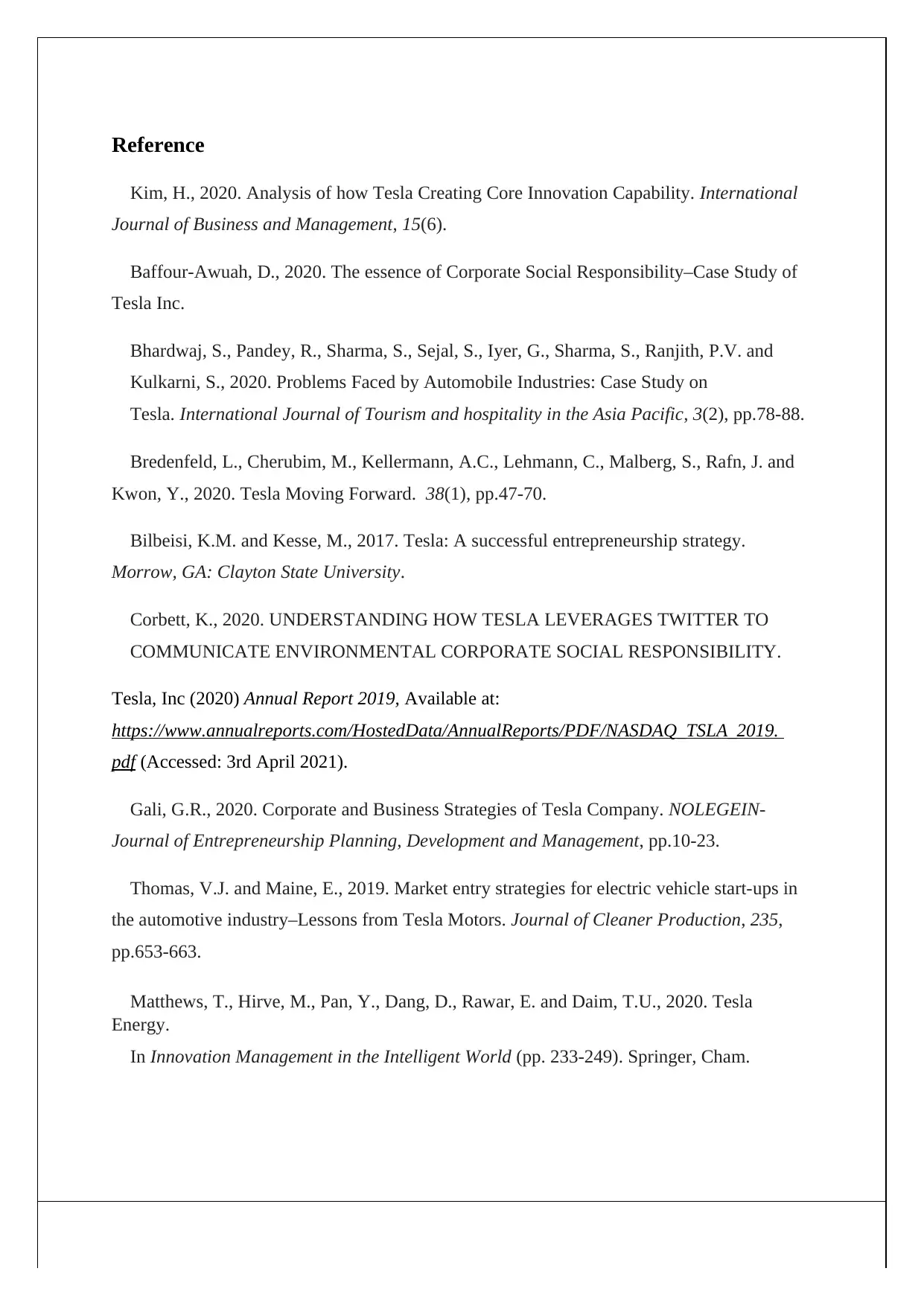
Reference
Kim, H., 2020. Analysis of how Tesla Creating Core Innovation Capability. International
Journal of Business and Management, 15(6).
Baffour-Awuah, D., 2020. The essence of Corporate Social Responsibility–Case Study of
Tesla Inc.
Bhardwaj, S., Pandey, R., Sharma, S., Sejal, S., Iyer, G., Sharma, S., Ranjith, P.V. and
Kulkarni, S., 2020. Problems Faced by Automobile Industries: Case Study on
Tesla. International Journal of Tourism and hospitality in the Asia Pacific, 3(2), pp.78-88.
Bredenfeld, L., Cherubim, M., Kellermann, A.C., Lehmann, C., Malberg, S., Rafn, J. and
Kwon, Y., 2020. Tesla Moving Forward. 38(1), pp.47-70.
Bilbeisi, K.M. and Kesse, M., 2017. Tesla: A successful entrepreneurship strategy.
Morrow, GA: Clayton State University.
Corbett, K., 2020. UNDERSTANDING HOW TESLA LEVERAGES TWITTER TO
COMMUNICATE ENVIRONMENTAL CORPORATE SOCIAL RESPONSIBILITY.
Tesla, Inc (2020) Annual Report 2019, Available at:
https://www.annualreports.com/HostedData/AnnualReports/PDF/NASDAQ_TSLA_2019.
pdf (Accessed: 3rd April 2021).
Gali, G.R., 2020. Corporate and Business Strategies of Tesla Company. NOLEGEIN-
Journal of Entrepreneurship Planning, Development and Management, pp.10-23.
Thomas, V.J. and Maine, E., 2019. Market entry strategies for electric vehicle start-ups in
the automotive industry–Lessons from Tesla Motors. Journal of Cleaner Production, 235,
pp.653-663.
Matthews, T., Hirve, M., Pan, Y., Dang, D., Rawar, E. and Daim, T.U., 2020. Tesla
Energy.
In Innovation Management in the Intelligent World (pp. 233-249). Springer, Cham.
Kim, H., 2020. Analysis of how Tesla Creating Core Innovation Capability. International
Journal of Business and Management, 15(6).
Baffour-Awuah, D., 2020. The essence of Corporate Social Responsibility–Case Study of
Tesla Inc.
Bhardwaj, S., Pandey, R., Sharma, S., Sejal, S., Iyer, G., Sharma, S., Ranjith, P.V. and
Kulkarni, S., 2020. Problems Faced by Automobile Industries: Case Study on
Tesla. International Journal of Tourism and hospitality in the Asia Pacific, 3(2), pp.78-88.
Bredenfeld, L., Cherubim, M., Kellermann, A.C., Lehmann, C., Malberg, S., Rafn, J. and
Kwon, Y., 2020. Tesla Moving Forward. 38(1), pp.47-70.
Bilbeisi, K.M. and Kesse, M., 2017. Tesla: A successful entrepreneurship strategy.
Morrow, GA: Clayton State University.
Corbett, K., 2020. UNDERSTANDING HOW TESLA LEVERAGES TWITTER TO
COMMUNICATE ENVIRONMENTAL CORPORATE SOCIAL RESPONSIBILITY.
Tesla, Inc (2020) Annual Report 2019, Available at:
https://www.annualreports.com/HostedData/AnnualReports/PDF/NASDAQ_TSLA_2019.
pdf (Accessed: 3rd April 2021).
Gali, G.R., 2020. Corporate and Business Strategies of Tesla Company. NOLEGEIN-
Journal of Entrepreneurship Planning, Development and Management, pp.10-23.
Thomas, V.J. and Maine, E., 2019. Market entry strategies for electric vehicle start-ups in
the automotive industry–Lessons from Tesla Motors. Journal of Cleaner Production, 235,
pp.653-663.
Matthews, T., Hirve, M., Pan, Y., Dang, D., Rawar, E. and Daim, T.U., 2020. Tesla
Energy.
In Innovation Management in the Intelligent World (pp. 233-249). Springer, Cham.
⊘ This is a preview!⊘
Do you want full access?
Subscribe today to unlock all pages.

Trusted by 1+ million students worldwide
1 out of 9
Related Documents
Your All-in-One AI-Powered Toolkit for Academic Success.
+13062052269
info@desklib.com
Available 24*7 on WhatsApp / Email
![[object Object]](/_next/static/media/star-bottom.7253800d.svg)
Unlock your academic potential
Copyright © 2020–2025 A2Z Services. All Rights Reserved. Developed and managed by ZUCOL.





